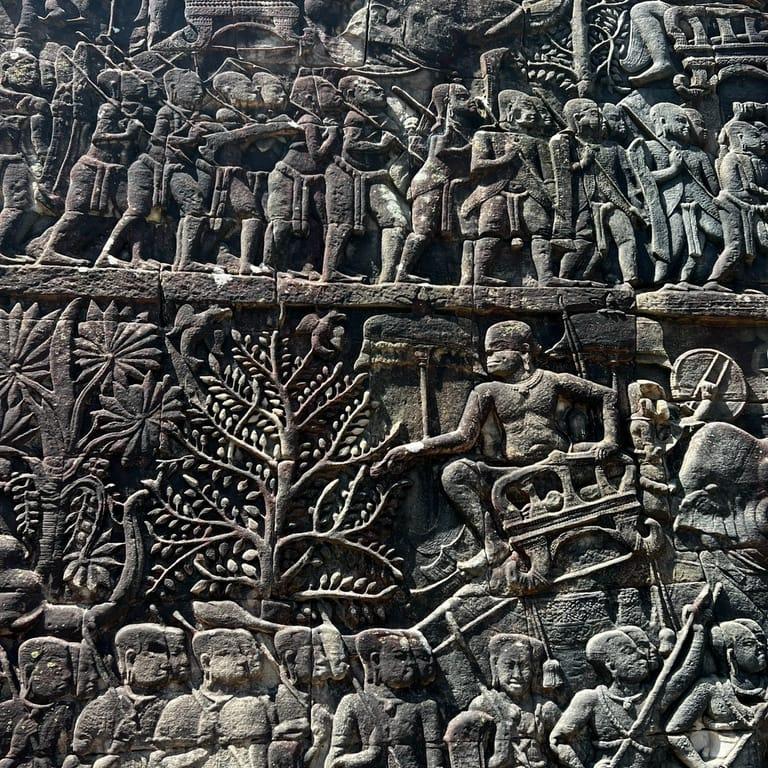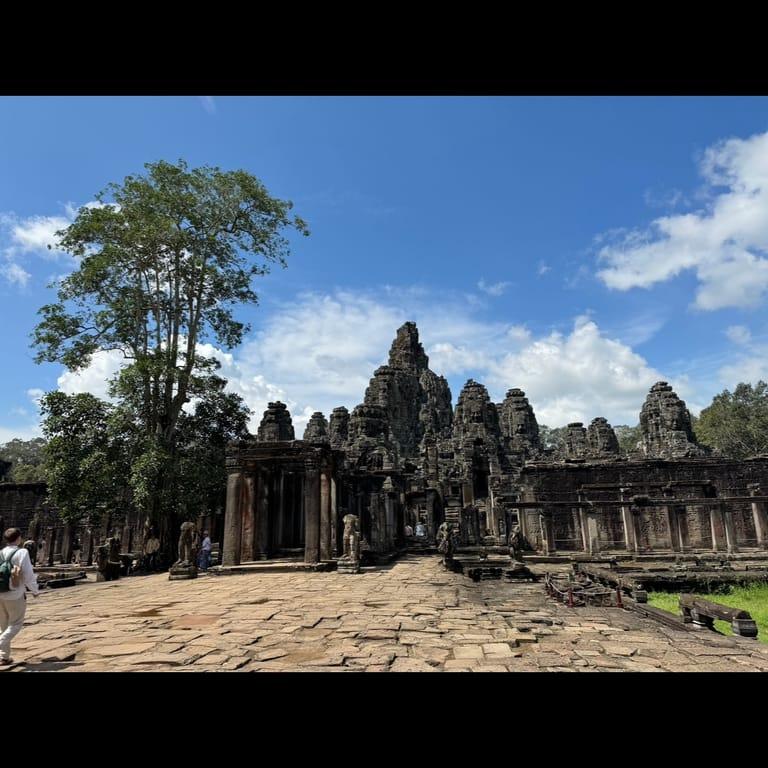Nestled in the heart of Siem Reap's ancient city, Bayon Temple stands as a breathtaking testament to Khmer art and spirituality. This 12th-century marvel is famed for its enigmatic 200 smiling faces carved into massive stone towers, making it an iconic highlight of the Angkor Archaeological Park. Visitors are captivated not only by the temple's grand scale but also by the intricate bas-reliefs that depict vivid stories of historical battles and everyday life in the Khmer empire.
Bayon Temple's architecture is unlike any other in Cambodia. Its central location within Angkor Thom, the ancient walled city, offers visitors a chance to experience a serene ambiance surrounded by stone faces that seem to watch over the landscape. Walking through its maze-like corridors, you'll encounter bas-reliefs that bring Khmer history and mythology to life, enriching your understanding of the culture and religious devotion that shaped this masterpiece.
- Timing to Visit: Early morning or late afternoon are the perfect times to avoid crowds and enjoy cooler temperatures.
- Entry Fee: No separate fee is required for Bayon Temple as its entrance is covered by the Angkor Pass.
- Facilities: Basic amenities including restrooms and souvenir shops are conveniently located near the temple.
Overwhelmingly praised for its unique smiling faces and detailed bas-reliefs , Bayon Temple offers a spiritual and historical experience that immerses visitors in the grandeur of the Khmer empire. Whether you're a passionate history buff, an avid photographer, or a traveler seeking tranquility, this temple provides an unforgettable adventure amidst Cambodia's rich heritage.
Nestled in the heart of Siem Reap Province, Cambodia, the Bayon Temple is a mesmerizing historical marvel dating back to the late 12th century. This iconic temple stands out for its unique architectural design and the enigmatic over 200 smiling stone faces that adorn its 54 towers, captivating visitors and historians alike.
Construction of this majestic temple began around 1181 under the reign of King Jayavarman VII, a visionary ruler who infused the site with Mahayana Buddhist influences. The temple was designed not only as a place of worship but also as a symbolic representation of the king’s divine authority and spiritual vision.
In the 13th century, during the reign of King Jayavarman VIII, Bayon Temple underwent significant modifications reflecting the empire’s brief return to Hinduism. These changes illustrate the rich religious tapestry and political shifts in ancient Cambodia, making Bayon a living museum of spiritual history.
Today, Bayon Temple is celebrated as a UNESCO World Heritage Site, acknowledged for its breathtaking artistry and cultural importance. Its exquisite stone carvings and serene faces continue to draw travelers, historians, and photographers eager to experience one of Cambodia’s most treasured landmarks.
- 1181: Construction of Bayon Temple begins under King Jayavarman VII.
- 13th century: Temple undergoes modifications during the reign of King Jayavarman VIII reflecting religious changes.
- 20th century: Bayon Temple is recognized as a UNESCO World Heritage Site, ensuring its historical preservation.
Bayon Temple, nestled in the historic city of Siem Reap within Cambodia's Angkor Thom complex, stands as a breathtaking testament to 12th-century Khmer architecture and spirituality. This UNESCO World Heritage Site is renowned for its striking feature: over 200 large stone faces with enigmatic smiles carved into its walls, providing visitors a unique glimpse into ancient religious artistry. Rich in history and cultural significance, Bayon offers an immersive experience that draws history buffs, cultural enthusiasts, and travelers seeking serenity alike.
The temple’s architecture is truly distinctive, with its maze-like corridors and smiling faces that seem to watch over visitors from every angle. Positioned centrally within Angkor Thom, Bayon is remarkably accessible for travelers exploring the ancient city. The spiritual atmosphere is palpable, inviting visitors to soak in the tranquil environment while reflecting on the temple's religious heritage. Additionally, the site is well maintained, ensuring that the intricate carvings and structures remain preserved for generations to come.
Despite its many attractions, visitors should be prepared for some challenges. The temple can become quite crowded during peak tourist seasons, particularly in the mornings when many guided tours converge. Some sections of the temple might be under restoration, which can limit access and slightly alter the experience. Furthermore, the terrain is uneven with steep stairs, which could pose difficulties for those with mobility concerns. Planning your visit later in the day can help avoid crowds and allow for a more peaceful exploration.
- Visit timing – Aim to explore the temple in the late afternoon to experience fewer crowds and enjoy the golden hour light illuminating the faces.
- Prepare physically – Comfortable shoes and readiness for considerable walking and stair climbing will enhance your experience.
- Purchase tickets early – Obtain your Angkor Pass in the city beforehand to avoid delays and ensure smooth entry.




